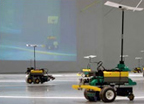
Social Network for Robots and Humans
"In a special edition of El Pais Digital reporting the Arco festival in 2001, the Spanish artist Ricardo Iglesias, one of the net art pioneers in his country, said that nothing or almost nothing ("only cliché") can be said about net art in five or six lines. However he mentioned a series of isolated topics that interconnected, related to each other, that'd really express net art: the network, the global and decentralized communication, interactivity, the virtual spaces, telepresence, the chaos theory, the active and interactive principle, the telematic interfaces, the post-biological culture, the hypertextual perspective, on line-chat, the rhizome image and the state of uncertainty.
His latest artwork, Independent Robotic Community, is a sum of all of the above. Developed with Gerald Kogler the project focuses on new forms of interaction between robots and humans on two levels.The first one features a community of 20 small robots divided in two groups. Each group has a primary level of socialization and a series of sounds conforming with a single vocabulary. Each robot's initial state consists of a very simple movement within a delimitated spatial environment. When it comes across other robots, it swaps data about its state with sounds and increases its degree of socialization and the complexity of its movements. On a second level humans can interact with robots using mobile phones and Internet, communicating with them in real time and further influencing the socialization process within the independent groups. The result is an original visual representation of a social network that includes both the subjective point of view of a spy camera and the graphic display of social statistics. As to confirm that net art is the art of networking." Valentina Culatti, Neural.

